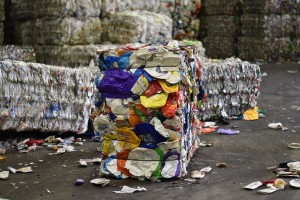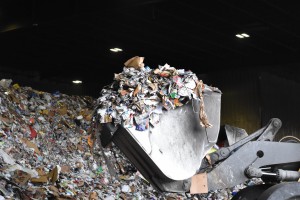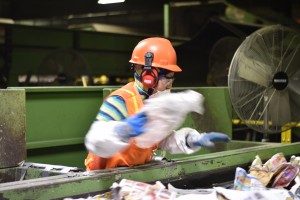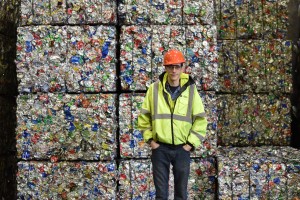Our trash and recycling miraculously evaporate each week. We fill bins with discarded odds and ends, we pull them out to the curb whether in Coventry or Little Compton, and “poof!” the bins are empty the next time we look.
Of course, there are magicians behind this trick. Few people get a grade on their recycling habits and many of us have no idea what happens to those Amazon Prime boxes after they leave our Ocean State curbs. Despite rarely glimpsing the story behind-the-bins, we can all follow the simple rules of Rhode Island recycling and, as a result, keep the magic happening. But understanding what’s behind the curtain puts the process (and the urgent practicality of recycling) in context – there are critical economic and environmental reasons to get this right. In honor of America Recycles Day (November 15), Motif took a tour of Rhode Island’s recycling facility. Who are the humans and machines that keep this process going, and how does this disappearing act work?

(Credit: Vin Sowders)
Rhode Island’s Materials Recycling Facility, or “MRF” (say it “Murf”), looks like a boxy warehouse from the parking lot, but within its cavernous chamber, it is in fact an elaborate maze of green and yellow chutes and ladders. The contents of our recycling bins from all 39 of Little Rhody’s municipalities move through winding conveyor belts: from massive container vehicles to an eroding mountain of papers and bottles and cans to a shallow stream flowing and diverging through human hands and infrared detectors and shaking sorters – to finally emerge as neat Lego-blocks of sorted recycling that are sold for re-processing around the world.

The MRF is located in Johnston, next to the state’s landfill, and is managed by the quasi-state, non-profit agency Rhode Island Resource and Recovery Corporation (RIRRC). Each of Rhode Island’s municipalities runs their own recycling collection programs, but it all flows to RIRRC. Brian Dubis, MRF operations supervisor, has worked at the facility for more than two decades. In a bright orange vest and hat, he explains the loud, twisting machines that convert heaps of jumbled materials into sellable blocks of sorted recycling. It’s simple, but we complicate it, he emphasizes. If Rhode Islanders followed the basic rules, the recycling facility would be in great shape. No more lithium battery or propane tank fires (something that happens around once every two weeks due to the intrusion of these materials that do not belong in your recycling bin), no more plastic bags clogging the machines, no more rogue dirty diapers, and no full bottles of soda jumping into the heavier metal recycling stream – to name a few problems that happen with some frequency. It’s easy to see recycling contamination while walking through the first rows of conveyor belts in the MRF – and it’s impressive to watch it dwindle as conveyors send materials past one kind of machine, then a set of hands and eyes, then another. Machines use magnets, electric currents, light and air to sort your recycling bin into neat rows. Practiced workers grab improperly recycled materials from the layer that swims past, at about 50 picks per minute. It’s a humanoid sorting process – (wo)man and machine, powers combined. You can take your own virtual tour of the facility by watching RIRRC’s video and witness the spectacle.

But this complex system doesn’t begin and end in Johnston. Each Rhode Islander is part of this magic act, whether we think about it or not. Education is, therefore, a critically important component of RIRRC’s work, and Motif spoke with Krystal Noiseux, education and outreach manager at the RIRRC, to get the run-down on recycling in the Ocean State.

Judee Burr (Motif): How is Rhode Island doing with our recycling? Are Rhode Islanders good at it?
Krystal Noiseux: It’s hard to give a grade. Because, in one sense, when we look at what’s still going into the landfill and how much of that could have been recycled at least in our basic mixed recycled program, we actually are doing really well compared to other states. We looked at what is still in the trash and what percentage of the trash could have been pulled out by even just the basic mixed recycling program, and it’s around 10%…So I know we’re capturing a lot of the material.
But the counterpoint to that is that we are seeing – it’s sort of been over the past two years – a steady rise in the amount of trash that we’re getting in the mixed recycling. When we get trash in the mixed recycling, one of three things can happen: It’s sort of an acceptable level, there’s always gonna be some stuff in there that doesn’t belong, you know, no one’s perfect, everyone makes mistakes, and our facility here is designed to handle that and process that. But there are times where we get so much trash in the mixed recycling that either part of the load has to be rejected and has to be landfilled, or an entire load has to be rejected and landfilled. When that happens, that’s really unfortunate, because there could be up to 70% of good material, but it’s also just covered in things like paint and food waste and dirty diapers and liquids and beverages and that can ruin an entirely otherwise good recycling load.
Our big message here now, especially on America Recycles Day, is that we want to see every Rhode Islander recycling everything they can that is accepted in our mixed recycles program, but nothing more.
JB: Could you give me the basic, two-minute run down of what is recyclable in Rhode Island?
KN: When it comes to the mixed recycling – so that’s your bin or cart at home, at school, at work – I think it’s important to note that depending on where you are in Rhode Island that bin or that cart could be a different size, a different color, a different shape, but it’s all the same mixed recycling program in Rhode Island; we have one unified program.
Within the mixed recycling, there are four categories of material that we accept, and if we could get people to stick to the four categories and basically exclude anything that doesn’t fit nicely and neatly into them, we would be in great shape.
The first category is for fiber, and what we accept is paper, cardboard and cartons. We don’t take any other type of fiber materials.
Category two is metal, and in the metal category, we take cans, lids and foil. That’s it, no other metal. So a metal frying pan is metal, but it’s not a can, lid or foil, so it doesn’t belong in your mixed recycling.
For glass, we have bottles and jars. No other glass.
Our final category is plastic, and that rule is very easy: the item has to be a container. So, a plastic hanger is plastic, but it’s not a container so it should never go in your bin or cart.
And the most basic rule for preparation that we need people to remember: empty at a minimum, rinse whenever possible. So those containers, most of the time you’re at home, you’re in the kitchen, there’s a sink there, you can rinse ‘em. Other times, you might be out at the ballpark and you finish your Gatorade and you can’t rinse it – but it’s empty at a minimum, rinse whenever possible.
And the other really important thing with preparation is no plastic bags. And not just no plastic bags thrown in there loosely, but not putting your recycling inside of a plastic bag. We need your recycling to be loose.
JB: My dad taught me to recycle – and we’ve had some debates over the minute details of what is recyclable. Here are some nitty-gritty recycling questions for those who think about it a lot and want to go beyond the basics:
What about pizza boxes with oil stains?
KN: We don’t want any more than a trace of food or beverage residue. If there’s just a little bit of grease, it’s not a problem. If you had a delicious pizza that was sopping with grease and cheese and sauce and the whole bottom of the cardboard was just ruined, then use your best judgment. You can rip off the dry top and recycle that and you can trash the other piece.
JB: What about plastic containers full of oil from your salad?
KN: Again, it’s that idea of only a trace left – if you have leftover food in there that you’re not finishing, we don’t want that with food in it. If you have a little bit of trace residue, it’s not a problem – I often will grab the napkin that I wiped my mouth with and just wipe it out. A trace of residue is the least of our concerns, we want it to be empty.
JB: What about the plastic film on the front of some letters – is that paper still recyclable?
KN: If there’s a little bit of something else on the item, it’s fine, it’s not a big deal, and you gave a perfect example – a little window on an envelope. A staple in my papers, a little binding on my notebook, a little metal spring inside the plastic trigger on my plastic spray bottle. Just a little bit of something else is not a big deal. When we cross into “a lot a bit” of something else, there’s a lot of packaging these days – we refer to it in the industry as “hybrid” – like a bubble-wrap padded envelope. It’s half of one thing and half of another and it’s just too much. If you’re like – “is this paper or is this plastic?” – it’s trash.
JB: What about those to-go coffee cups with an inner lining of plastic?
KN: Wet-strength paper board is notoriously difficult for recyclers. It’s not something that they really want – it’s very hard for that to break down in their paper mills and in their systems. You just gave a perfect example of a paper coffee cup – that’s not just plain paper board, if it was, the coffee would melt through and burn your hand off. It’s got that poly liner. So, there are exceptions, and, in the end, we’re pulling those things out.
JB: Last one – do we have to take the bottle caps off of plastic bottles?
KN: You don’t. Here’s the general rule: plastic goes back on plastic, metal comes off of glass. Plastic has to go back on plastic because the tops are usually too flat or too small to travel through the system on their own, they literally need a ride to get to the other end of the system.
JB: Are there other common recycling mistakes that Rhode Islanders make that are related to the general rules?
KN: The only other thing that I would say that’s really high-level important and it’s included on those basic guidelines – there’s two exceptions to the plastic container rule that are key.
One of them is: no foam containers. A lot of people will call it styrofoam. We also don’t want plastic containers that contain flammable materials or oily chemicals. So think of your automotive fluid bottles, like gasoline, motor oil, antifreeze, things of that nature. Those are best suited when they’re empty for the trash, because they’re not really empty ever.
At the most basic level, if we got people to know those four categories, exclude everything that doesn’t fit neatly in them, keep their recycling loose and make sure things are emptied at a minimum but rinsed whenever possible, we’re in really good shape. If we could get people to further keep out the shredded paper, the sanitary napkins, tissues, foam containers and those containers from those flammable, oily chemicals, then we are in great shape. Like great shape, statewide. And then, for those people who are super passionate about it, you can find out more – not only more things that you can keep out, but also more tips for properly preparing your recycling for pick-up. And that’s just like “gold star.” We call those people our super recyclers.
JB: That would be fun to get a gold star on your recycling bin.
KN: Yes! We talk about this all the time. City of Providence and west side of Pawtucket – those are our two hot spots for contamination where we’re seeing the worst levels of contamination in the state. And cities and towns are actually the ones responsible for the bins and the carts and the collection. So we rely on them to be the eyes and ears on the ground and be doing the enforcement. It’s usually just relegated to telling people when they’ve done something wrong, verses also telling someone when they’ve done something right and giving them the gold star on their bin. We’d love to see more cities and towns out on the road doing that sort of thing, positive reinforcement as well as the collections.
JB: RIRRC also manages the state’s landfill, right?
KN: In addition to the Central Landfill, we have the composting operation, we handle more than half of the state’s yard waste, we have the Materials Recycling Facility – those are our “big three.” But then we also have our drop-off center for harder-to-recycle materials here, and we have our eco-depot, that’s our special collection program for household hazardous waste.
JB: Does Wall-ee strike a chord down in Johnston?
KN: Yeah! The kids will say it right away when they’re in the Materials Recycling Facility. A lot of people will come here and they don’t even realize what we do – we take it in mixed, we sort it, we sell it to the recyclers. The end of that process is a baling process where we make these giant cubes or compressed materials, and the kids, right away, are like “Wall-ee! Wall-ee! Wall-ee! The cubes, it’s Wall-ee!”
JB: Do you work to educate people about the materials they’re purchasing, or even before that, work with producers in Rhode Island to streamline waste?
KN: We definitely encourage waste reduction and materials reuse. So through our educational programs we’re doing that. For example, we have a workshop we teach just about preventing food waste, preventing food from going bad in your fridge. Or education on how to make sure you’re buying the right amount of paint to begin with? Or what are the things that you can do in your office to print less? We do that as part of our education and our technical assistance when we’re going into businesses and organizations to help them start or improve their program. We also encourage reuse. Rhode Island does have a few extended producer responsibility laws, where manufacturers are responsible for the actual program to recycle their products in the end or to at least fund the recycling of their products at the end of their life. We do have that in Rhode Island – we have it for TVs, for computers, for mattresses, for paint, for mercury-containing devices. So there is a little of that as well.
JB: Why is recycling important? For some people whose buildings don’t recycle or the recycling bin is far away – isn’t it easier to put the beer bottle in the trash and never think about it again?
KN: One of the hardest things for me as an educator is that what I’m trying to educate the public about is so out-of-sight, out-of-mind by its nature. You put things on the curb, or you leave them in your bin at work and you go home that night, and it just goes away. It just goes away! And, if you don’t know, “away” is a real place. It’s in Johnston – I work here, a lot of people work here. And just the finite nature of our Central Landfill – the last time that we did our statewide plan a couple years ago, we were projecting that closure would be in 2038. And that would be the first time in the history of the state of Rhode Island where we don’t have a central landfill for our waste.
Some people have an environmental motivation behind it – they might think about the space of the landfill, they might think about the energy savings with recycling, the natural resources that we’re saving because if we’re making new things from old things then we don’t have to go and mine, or deforest or dredge and that.
But you could just look at it purely from an economic standpoint, that we just have this really affordable, great resource in the center of our state. That once that’s gone, whatever we have to do next we’re not sure what it’s going to be. It’s going to be extremely expensive for the next generation of Rhode Islanders – so it’s an intergenerational equity thing, too. Even just thinking about your kids or your nieces or your nephews or your grandchildren, what the financial implications are for them and what kind of world, what kind of state are we leaving them.
You can read Krystal’s responses to more recycling questions in the Providence Journal, where she keeps Rhode Islanders in-the-know about the latest tips and tricks. Go to RecycleTogetherRI.org for more information on these basics of Rhode Island’s mixed recycling program.
More Posts by The Author:
Extreme Weather: Challenges to local farming in a fast-warming region
Providence Electric Bike-Share Program to Launch in June
More Parking, Wider Roads, Bigger Houses and Yards? How Outdated Laws Get in the Way of Sustainable Community Planning
Six Months After Hurricane Maria: Puerto Rico At the Intersection of Racial Injustice and Climate Change
A Year Later: Progress on the 1,000 MW Clean Energy Goal for RI


